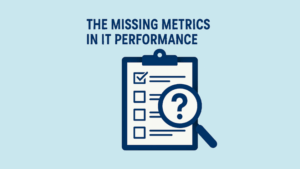The Missing Metrics in IT Performance

IT organizations are awash in data. We measure service levels, ticket resolution times, uptime percentages, and project delivery stats. These metrics tell us if we’re operating efficiently—but not whether we’re making a strategic impact.
That’s a problem.
Because when business leaders assess IT, they’re not asking, “How fast did you close that ticket?” They’re asking:
- Does IT understand my goals?
- Are we aligned on priorities?
- Do I trust their judgment?
- Is IT helping the business move forward?
In our work across industries, we’ve found that fewer than 1 in 4 IT organizations consistently measure performance from the stakeholder’s perspective. And those that think they do often rely on vague satisfaction scores or anecdotal feedback—tools that offer little guidance on what to change or how to improve.
Here’s what the data shows:
- IT teams that track stakeholder alignment and trust see up to 30% greater improvements in business perception year-over-year.
- Organizations that gather structured feedback from business partners are twice as likely to be seen as strategic contributors.
- In many enterprises, the largest gaps in IT performance aren’t technical—they’re in communication, prioritization, and perceived value.
What’s missing isn’t more metrics. It’s the right metrics—focused on how IT is experienced by those it’s meant to serve.
Until we measure that, we’re flying blind. And we’re missing the most important signal of all: whether IT is truly helping the business succeed.
In the weeks ahead, I’ll be sharing more on how IT can move from operational reporting to strategic performance—and what that journey looks like when done right.
One thing to watch for: It’s much more than just hard data metrics. AI-driven interrogation of stakeholder experiences is offering incredibly valuable insight into what trust and quality really mean—for them.


